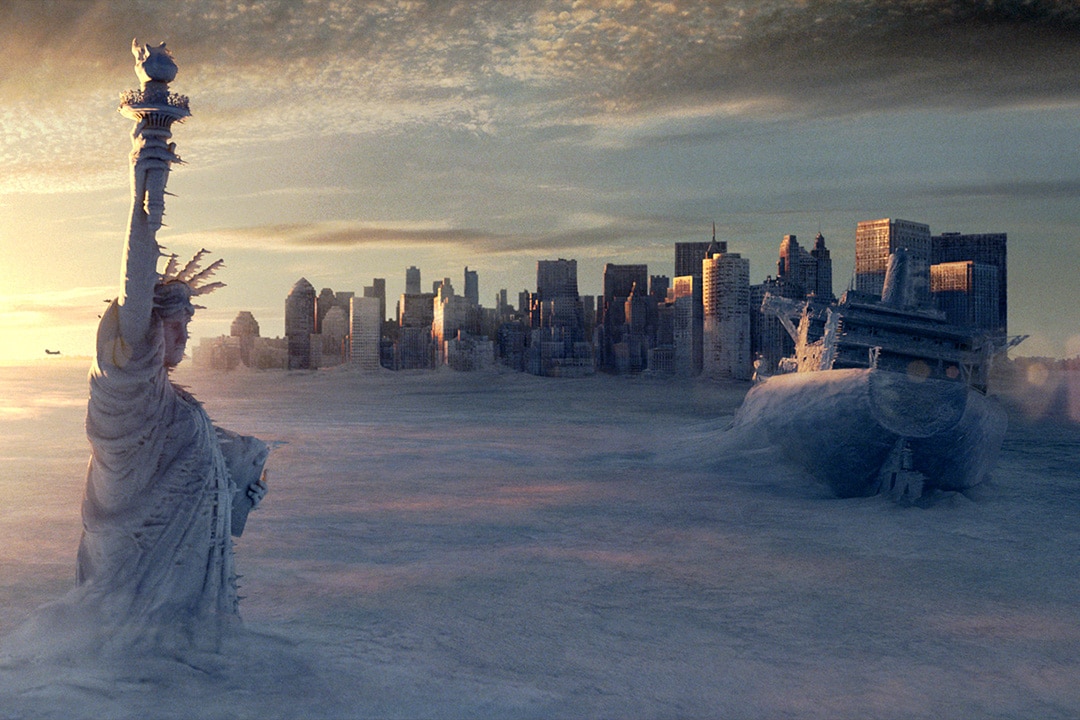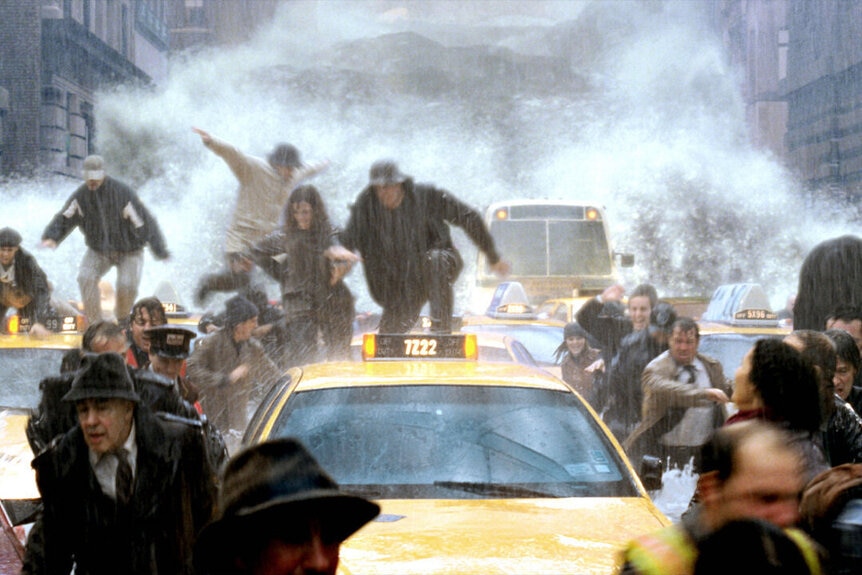Create a free profile to get unlimited access to exclusive videos, sweepstakes, and more!
20 Years Later, This Blockbuster Roland Emmerich Disaster Flick is Still Ahead of its Time
The 2004 disaster flick is more relevant today than it was 20 years ago.

By the early 2000s, Roland Emmerich had established himself as Hollywood's resident master of disaster. After tackling malevolent aliens in Independence Day and mutated lizards in Godzilla, the filmmaker set his sights on a more hard-hitting topic: climate change. The result was 2004's The Day After Tomorrow (now streaming on Peacock), which tried to sound the alarm on what awaits us on the other end of environmental devastation... while also serving as a rollicking Hollywood blockbuster chock full of eye-popping visual effects.
"We had no idea how prescient the movie would be," admits co-writer Jeffrey Nachmanoff over a Zoom call with SYFY WIRE. "It was undertaken in the spirit of both entertainment and a little bit of a cautionary tale. We thought we were taking a wild, dramatic license to create these weather and other climate disasters that we portrayed in the movie. But unfortunately, those have proven to be far less extreme or ridiculous than people thought they were when the movie came out."
The origin of Roland Emmerich's The Day After Tomorrow
Loosely based on the 1999 book The Coming Global Superstorm, written by Art Bell and Whitley Strieber, the big-budget disaster flick — which turns 20 this year — centers around the concept of abrupt climate change: hail the size of cinderblocks rain down in Japan, skyscraper-sized tornadoes destroy downtown Los Angeles, a tsunami floods Manhattan, and a massive storm covers the northern hemisphere with a new ice age.
During the script-writing process, Nachmanoff traveled to Washington DC, to consult with scientists from NOAA and the National Weather Service. He reveals that the title, which is never said aloud in the film, "wasn't anything particularly deep," but a reference to just how soon our lives could be upended by fluctuations in weather. "We were saying, ‘This is right around the corner, this is what's going to happen.’"
At the time, 20th Century Fox (now called 20th Century Studios under Disney's ownership) wanted to promote the project as a sci-fi thriller and steer clear of any hot-button messaging. "They said, ‘We’re very excited to be making this movie, we just want to make one thing clear: we don't want to use the term 'global warming' when we talk about this movie,'" Nachmanoff says of the first marketing meeting. "I was trying not to spit out my free bottle of Evian water."
The funny part is that the movie's central point of conflict revolves around a lone scientist — Jack Hall (played by Dennis Quaid) — trying to warn an obstinate government, whose vice president (Kenneth Welsh) looks a heck of a lot like Dick Cheney.
"That was definitely pointed out by a lot of people and some people accused us of being unfair to Dick Cheney," Nachmanoff says. "I pointed out that I didn't even write some of the lines, I literally copied lines that Dick Cheney had said in speeches ... They made themselves very easy targets, because the arguments were really simple and have always been the same ... Luckily, the debate has moved a long way. The debate now is, ‘Okay, here is a problem. What are the political solutions that are available? What are the solutions people can tolerate?’ As opposed to, 'There shouldn't be any effort to deal with it.'"
Another politically-tinged scene finds panicked U.S. citizens of the southern states illegally crossing the border into Mexico to avoid the icy onslaught. "I remember when it was shown in Mexico — I guess we went down there for a premiere in Mexico City — everybody cheered at the gringos goes coming across the border the wrong way to the current narrative."
Like Emmerich's previous blockbusters of the 1990s, The Day After Tomorrow was intended to be a cinematic spectacle of globe-trotting, monument-destroying, humanity-barely-surviving mayhem. "It's like with every Roland Emmerich film. I was like, ‘How the f*** are we going to do this?’" cinematographer Ueli Steiger remembers with a laugh.
The overall goal, explains the DP, was to strive for a "naturalistic" look that grounded the more outrageous elements of the story. "I just wanted this to look as normal as possible, which is difficult to do." Another challenge was lighting the actors in such a way that the audience would never know the players were "sweating like pigs" in heavy winter clothing under broiling studio lights.
Creating the Effects for The Day After Tomorrow
"I was like, ‘Oh, my God, how are we gonna do this?’" echoes VFX Supervisor Karen Goulekas. "That was only 2002 [when] I would have read the stuff. And when I read there was a ship coming down Fifth Avenue, I was just like, ‘How the hell are we gonna do this?’ That was daunting stuff back then. I was excited at the challenge, but I was like, ‘Oh, sh**.’"
In an age when CGI was still evolving in the wake of Jurassic Park a decade prior, Goulekas and her team struggled to make rushing water and frozen landscapes look as "photo-real" as possible. "There was nothing that felt like a cakewalk in it," she admits. For the various shots of New York City buildings, a team spent three months in the Big Apple, scanning different structures from various heights.
"We'd have to get clearances to get on a first floor, a middle floor, up on the rooftop. The location scout had to deal with getting our guys up there. And it was cold," she adds. "I went to a couple of those rooftop shoots and I was like, ‘Oh, this sucks.' But they were troopers. They were out there every day and gathered a few hundred thousand textures."
The aforementioned ship moving down Fifth Avenue was entirely done with computer-generated effects. "They’re easier in the sense that you're not locked in on the camera," Goulekas says. "You don't have to do the camera tracking, you have more creative flexibility, but they can be harder in order to make it look photo-real."
But not everything was a digital illusion. For example, the scene where a number of characters seek refuge in the New York Public Library as water overtakes Manhattan was shot "on a stage with a tank," says the VFX supervisor. "We just had that foreground area with the practical cars and people and a couple of building facades. It wasn't a whole lot, but it was really critical that we had the foreground water and cars for people to interact with."
"I think it was nearly 200 extras in there," Steiger adds. "The water had to be heated, it had to be clean, the rain had to be clean. It was a big, big endeavor. [There were] people with oil barrels, making waves. It looked like a real tempest and panic … And outside the frame, you saw people with wind machines. That’s the fascinating thing about moviemaking."
Supervising Art Director Claude Paré put together a $26 million budget for all the "carpentry, paint, greens, cars, props, set dressing, and special effects" required for the Montreal-based production. The studio took one look at this figure and purportedly asked: "Are you sure there are enough people in Montreal to spend all that money?"
It was such a large undertaking, in fact, that a number of crew members were imported from the United Kingdom to help with set construction. "It took everything that we had in terms of manpower," Paré says. "It was extremely complex … The Day After Tomorrow was a big success and it built the credibility of Montreal in terms of being able to deliver a gigantic film."
Before shooting moved up north, the team filmed on location in Los Angeles for the sequence in which massive cyclones destroy the Hollywood Sign and Capitol Records Building. After all, a Roland Emmerich joint isn't complete without the wanton destruction of famous U.S. landmarks. "We had big Sikorsky helicopters loaded with sand to the maximum weight, hovering over us to make the wind. It was really something," Steiger recalls. "It was a real adventure and with these helicopters, you don't hear anything."
How to freeze an entire city
Once the ice age-level storm sets in, the characters must battle the elements, particularly when the temperature drops so drastically, that everything (be it helicopter fuel or the human body) instantly freezes in its path. Given that the "antagonist" of the film was so abstract, Emmerich really wanted to hammer home the terror of harsh weather.
"Early on, Roland very smartly said, ‘Jeffrey, we have to sort of personify or make manifest the danger as if it were a monster. We don't have an asteroid, we don't have aliens, so it has to be something that feels like that,'" states Nachmanoff. "And even the way he shot it, sometimes the camera’s chasing [the characters] down those corridors … it feels like a monster pursuing you."
While the idea of super-freezing air might sound like a far-fetched idea that could only come out of Hollywood, a scientist at NOAA actually came up with a scenario in which such an occurrence might feasibly happen:
"It rested on the idea that if a volcanic eruption happened [and] was leaking a small amount of particulate interference that escaped the notice of the sensors because it happened at some special elevation, it could collect in the upper troposphere in a place where we don't monitor and it could separate and the air could get colder and colder and colder. Then it would break through and a column of cold air would come down and it would freeze everything in its path. I said, ‘I really wish you hadn't told me that that was even possible.’ But, it was fun to see how these scientists could kind of get into the spirit of thinking about scenarios. People think things are kind of crazy or silly, but like if you talk to enough experts there are ways almost anything can happen."
The most memorable visual of the entire film (probably because it ended up on the theatrical poster) was the Statue of Liberty buried under hundreds of feet of snow in the middle of a frozen Hudson River. Nachmanoff says this was a deliberate homage to the famed twist ending of Planet of the Apes. "That movie is a great way to sort of completely shatter the audience's expectations of the world that they're in by having Charlton Heston see that Statue of Liberty. That one shot tells the whole story," he explains. "And obviously, by doing that in Day After Tomorrow, we're once again — hopefully — putting an image there in the mind of the viewers that says, ‘Imagine that!’"
It also fits into Emmerich's ethos of establishing a massive scale. "It makes you feel as if the whole world is involved," the writer concludes. "One of the big talking points of the current environmental movement is 'One Earth, One Planet.' The notion that there is 'No Planet B,' as you see on people’s T-shirts. It may be a little bit easy or trite, but it's also absolutely true."
The Day After Tomorrow is now streaming on Peacock.
Originally published Jul 7, 2023.




























